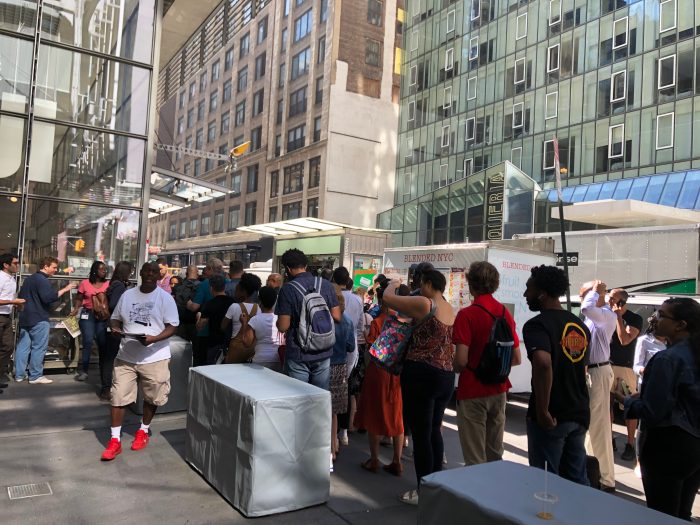
The New York Times’ 1619 Project magazine issue, which reframes American history in light of how it was and continues to be shaped by slavery, has turned out to be one of the must-read, must-discuss works of the summer; nearly two weeks after its publication, it’s still inspiring both rhapsodic praise and conservative backlash.
It’s also becoming a must-have physical item (display it on your coffee table! Just make sure you don’t spill coffee on it), kind of like how that New Yorker tote bag did two years ago. Copies of the August 18 issue are being offered for more than $100 on eBay. (The New York Times’ Nikole Hannah-Jones, the force behind the project, cautioned people to chill.)
On Thursday, between 10 AM and 2 PM or until supplies run out, the Times is handing out 2,000 free copies of the 1619 Project at its headquarters (40th St. and 8th Avenue) and…people are here for this.
THREAD: Got myself up and out the door at 8 am morning to go and pick up one of the most critically important publications of my lifetime. I want to to talk for a second about this experience. Walking over from the 42nd St, I was nervous that they’d run out of copies because NYC pic.twitter.com/3Z7toajuBS
— Zora Neale Hurtem (@zoranealehurtem) August 29, 2019
The feeling on line was electric; ppl of all races shared their stories of trying to find this magazine: “I got off bartending at 10pm and tried every bodega in the hood”, “I went to every bookstore I know”. But there was a special giddiness to the way *we*talked to each other.
— Zora Neale Hurtem (@zoranealehurtem) August 29, 2019
Standing off to the side were two other sisters about my age doing the same. We looked at each other, smiled, and laughed. Then we stuffed our copies in my bookbag, got back on line, and grabbed additional copies for loved ones.
— Zora Neale Hurtem (@zoranealehurtem) August 29, 2019
I share this to tell you how our history, our very existence inspires me: we look out for each other without even asking for it, we see each other everywhere, we claim joy as an act of resistance, we build community wherever we gather. Thank you, @nhannahjones for this experience
— Zora Neale Hurtem (@zoranealehurtem) August 29, 2019
Huge crowd at the NYT building today for FREE COPIES of the #1619Project. Plenty still left!! Come on down!! We’ll be handing them out until 2 pm (or the supply runs out). Get your free copy of this historic edition. (On 40th St just east of 8th Ave) pic.twitter.com/mddtA56RhL
— Jake Silverstein (@jakesilverstein) August 29, 2019
Shoutout to @nhannahjones and the @nytimes for the free copies! They're still giving them out at 40th St entrance of the NYT! #1619Project pic.twitter.com/k0J2SQnIYg
— Justine (@JustmeLitrell) August 29, 2019
Shoutout to @nhannahjones and the @nytimes for the free copies! They're still giving them out at 40th St entrance of the NYT! #1619Project pic.twitter.com/k0J2SQnIYg
— Justine (@JustmeLitrell) August 29, 2019
Bae works near the @nytimes, so when I saw @nhannahjones’ tweet…I asked him to grab a copy of the 1619 project. When it dropped, I was in a city & it was nowhere to be found. He said he only had a 10-minute break and it was 13 blocks. A no go.
Y’all.
This man must’ve ran. pic.twitter.com/mSWyzf9kBU— Erica B. (@ericabuddington) August 29, 2019
Jones said that the Times is “working on” paid issues, for those who aren’t in Manhattan this morning, or who accidentally recycled their paper, or whatever. The Pulitzer Center also has a free PDF and lesson plans, and the package is, of course, all available on the Times’ website.
For those asking, we are working on pay copies. These are copies we fund-raised for in order to distribute for free and so we cannot sell them or use them to fill orders.
— Ida Bae Wells (@nhannahjones) August 28, 2019
For now, I will continue to enjoy these line videos, which are *extremely heartwarming* at a time when we can use it.
This is incredible, and such a testament to the incredible work that went into the #1619Project. Congratulations to @nhannahjones and the entire team who poured their hearts into such an important work of journalism. I'm in awe. https://t.co/UJk9nGDV0Y
— Caitlin Moscatello (@caitmosc) August 29, 2019
Living out my dream of being a newsie on the streets of Manhattan #1619Project @TheOfficialBale pic.twitter.com/rdf0qLYnbq
— Lauren McCarthy (@laurenamccarth) August 29, 2019